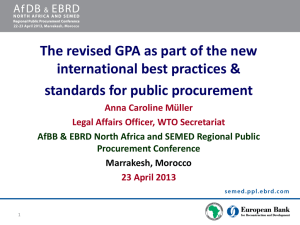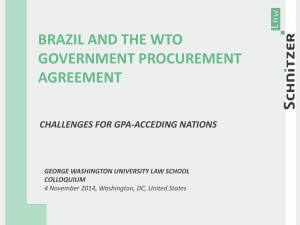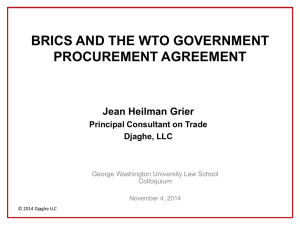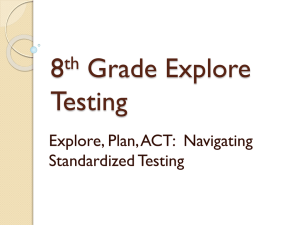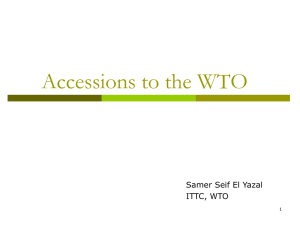The WTO Agreement on Government Procurement (GPA)
advertisement
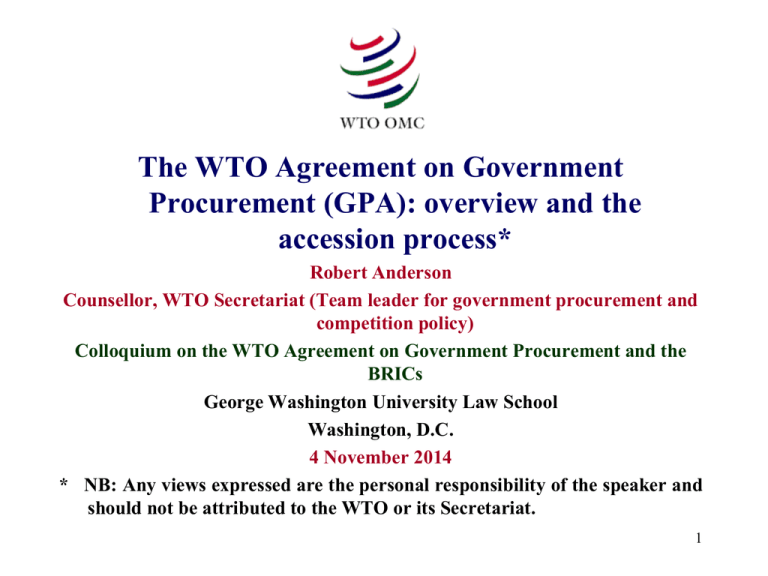
The WTO Agreement on Government Procurement (GPA): overview and the accession process* Robert Anderson Counsellor, WTO Secretariat (Team leader for government procurement and competition policy) Colloquium on the WTO Agreement on Government Procurement and the BRICs George Washington University Law School Washington, D.C. 4 November 2014 * NB: Any views expressed are the personal responsibility of the speaker and should not be attributed to the WTO or its Secretariat. 1 What is the GPA?: Basic nature of the Agreement An internationally recognized tool that promotes: Access to other GPA Parties’ procurement markets; Improved value for money in each participating Member’s procurements; Good governance (transparency, fair competition and an absence of corruption in covered procurement markets). A plurilateral agreement within the WTO system (not all WTO Members participate) Membership increasing over time. Several developing/transition economies currently pursuing/pondering accession. Well-aligned with the UNCITRAL Model Law on Procurement and set to be recognized in new World Bank Procurement Guidelines. 2 Five main elements of the Agreement (1) General rules on non-discrimination, national treatment and transparency with respect to each Party’s “covered procurement markets”. Coverage defined through detailed schedules (Annexes) in “Appendix I”. Specify covered entities, thresholds, covered services, specific exclusions, etc. NB: scope for accommodation of economic preferences/social policy considerations via the schedules. Minimum standards on aspects of the procurement process (based on international best practices), to ensure transparent and open competition. Includes provisions on: Tendering procedures and qualification of suppliers; Time limits, documentation, opening of tenders and contract award procedures. 3 Five main elements of the Agreement (cont’d) Enforcement provisions: (i) requirement of independent domestic review procedures (bid challenge or remedy systems); and (ii) the WTO-Dispute Settlement system. “Transitional measures” (S&D) to facilitate accession to the Agreement by developing economies. 4 The recent conclusion of the GPA renegotiation: overview NB: revised GPA is now in force (effective 6 April 2014) for the following GPA Parties: Aruba; Canada; the European Union (including its 28 member states); Hong Kong (China); Iceland; Israel; Japan; Liechtenstein; Norway; Singapore; Chinese Taipei; and the United States. Elements of the renegotiation: Revised text – modernized/greater flexibility/improved transitional measures for developing countries that join the Agreement. Market access enhancement package valued at $80-100 billion annually. A new set of “agreed Work Programmes” on issues such as Sustainability and Access to Procurement Activities by Small and Medium-sized Enterprises (SMEs). 5 The recent conclusion of the GPA renegotiation (2): key improvements in the revised GPA text Core principles of the revised text are the same as the existing one (nondiscrimination, transparency, procedural fairness). However, revised text incorporates: A complete revision of the wording of the provisions of the Agreement with a view to making them more streamlined, easier to understand and user-friendly; Updating of the text of the Agreement to take into account developments in current government procurement practice, notably the use of electronic tools; Additional flexibility for Parties' procurement authorities, for example in the form of shorter notice periods when electronic tools are used. Shorter time-periods have also been allowed for procuring goods and services of types that are available on the commercial marketplace; ….. 6 The recent conclusion of the GPA renegotiation (3): improvements in the revised GPA text (cont’d) More explicit recognition of the GPA's significance for good governance and the fight against corruption, including in new substantive provisions that require participating governments to carry out their GPA-covered procurements in ways that avoid conflicts of interest and prevent corrupt practices; and Revised and improved transitional measures ("special and differential treatment") for developing countries that accede to the Agreement. Under the revised provisions, such measures are to be tailored to the particular needs of the individual accession candidates. 7 The accession process: what does it involve? GPA accession open to all WTO Members. Based on terms to be negotiated between existing Parties and the acceding WTO Member. The terms to be negotiated include: (i) coverage; and (ii) transitional measures, if any. Upon accession, new Parties must have in place GPAcompliant national legislation. 8 Who is in the Agreement? Who is coming in? Already enrolled: the EU and its 28 member States; most other traditional developed countries (i.e. US, Canada, Japan; Norway, Switzerland and Liechtenstein); plus Hong Kong, China; Iceland; Israel; Korea; Singapore; Chinese Taipei; Aruba and Armenia. Approved for accession last week (!): Montenegro and New Zealand. Currently in the accession pipeline: Albania, China, Georgia, Jordan, the Kyrgyz Republic, Moldova, Oman, and Ukraine. Commitments to seek accession: Macedonia, Mongolia, Russia, Tajikistan and Saudi Arabia. 9 Observership in the Agreement: a possibility worth considering? Any WTO Member can become a GPA observer, just by making a request to the Committee. A mere request for observership does not imply a commitment to eventually become a Party. Currently, twenty-eight WTO Members have observer status under the Agreement: Albania, Argentina, Australia, Bahrain, Cameroon, Chile, China, Colombia, Georgia, India, Indonesia, Jordan, the Kyrgyz Republic, Malaysia, Moldova, Mongolia, Montenegro, New Zealand, Oman, Panama, Russia, Saudi Arabia, Sri Lanka, the former Yugoslav Republic of Macedonia, Tajikistan, Turkey, Ukraine and Viet Nam. 10
